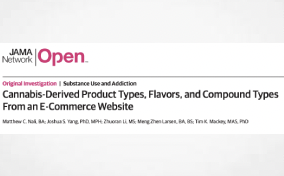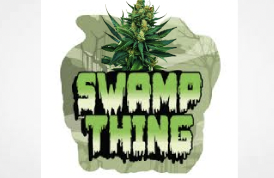Key Points
Question What types of cannabis products and their respective flavors are available on a cannabis e-commerce website?
Findings This qualitative study of 501 012 unique cannabis product listings sold in the US found that the top 3 routes of administration were multisystem (41%), respiratory (37%), and digestive (20%). The most common product categories were flower buds (20%), cartridges (12%), and joints (8%); the most common cannabinoid compound type was Δ9-tetrahydrocannabinol (63%); and among all products, 42% had at least 1 of 260 unique flavors.
Meaning Existing, new, and emerging characteristics of cannabis-derived products should be properly monitored and assessed for possible regulation and appropriate restrictions to ensure current and future safe and responsible adult use.
Importance Cannabis-derived products (CDPs) are widely available and diverse. A classification of product and flavor types is necessary to establish a foundation for comparative research, although research aiming to classify cannabis in its variety of products, flavors, and cannabinoid compounds based on public online e-commerce data is lacking.
Objective To analyze data from a large cannabis e-commerce marketplace to identify and characterize cannabis product types, flavors, and compound types.
Design, Setting, and Participants This qualitative study was conducted in 2 phases: (1) data mining of the cannabis e-commerce website Weedmaps for product listings in the US between September 1 and November 30, 2023 and (2) grouping CDPs into product, flavor, and cannabinoid compound categories.
Exposures Cannabis product listings.
Main Outcomes and Measures Product listings and descriptions were extracted from the platform. Coding was performed for specific product characteristics, routes of administration (ROAs), and characterization of flavors.
Results A total of 573 854 unique US CDP sales listings from the platform were collected; after removing 72 842 nonconsumable items, 501 012 were analyzed. Product ROAs included multisystem (205 637 [41.04%]), respiratory (185 296 [36.98%]), digestive (98 941 [19.75%]), epidermal (9487 [1.89%]), and oral (1651 [0.33%]). Nearly half (210 575 [42.03%]) of all product listings included at least 1 flavor, with 247 762 instances of flavors. The 3 most common flavors were lemon (22 106 [8.92%]), cake (19 463 [7.86%]), and strawberry (13 961 [5.63%]). The most common cannabinoid compound type was Δ9-tetrahydrocannabinol (54 699 [63.30%]).
Conclusions and Relevance This qualitative study categorized more than half a million CDPs for product and flavor types. Results are needed for comparative studies on product and market availability and can help in assessing concerns about appealing characteristics. The results can also inform future market surveillance efforts aimed at identifying new and emerging products as cannabis policy continues to move toward greater legalization.
The policy environment regulating cannabis (including marijuana and hemp) has changed dramatically in a short period of time.1,2 As of February 2024, 24 US states had legalized nonmedical (ie, recreational) and medical cannabis use, with an additional 14 states permitting medical marijuana only, a rapid rise since Colorado and Washington first legalized recreational use of marijuana in 2012.3,4 Although cannabis remains a Schedule I substance under the Federal Controlled Substance Act, where any form of cultivation, distribution, and/or possession remains illegal, the Agricultural Improvement Act (also known as the 2018 Farm Bill) excluded hemp and cannabis derivates (eg, cannabis products with tetrahydrocannabinol [THC] under 0.3% on a dry basis), leading to new types of derived psychoactive cannabis products being sold in the US.5–8
Research suggests that cannabis legalization may be positively associated with cannabis use and cannabis use disorder.9 Cannabis is the most commonly used illicit drug in the US, with 50.7% of US residents 12 years and older reporting lifetime cannabis use, 24.9% reporting past year use, and 16.5% reporting past month use in 2022, all increases over similar patterns in 2021 and reflecting an increase in cannabis use among adults over time.9,10 While other drug and alcohol use among adolescents has been trending downward in recent decades, prevalence of cannabis use has fluctuated at similar or increased levels in the same period of time.11 Specific to young adults, the Monitoring the Future survey12 reported that in 2022, among younger adults aged 19 to 30 years, those reporting past-year and daily cannabis use had reached the highest levels ever.
One avenue where cannabis legalization may impact use is expansion of not only the number of products available but also the types and appeal of products through market innovations. Products vary by route of administration (ROAs) (eg, oral, inhaled), potency, compound composition (eg, Δ9-THC, cannabidiol, cannabichromene), characterizing features (eg, flavoring), and product type (eg, flower, concentrate).6,13 Product variability is reflected in an expanding array of cannabis-derived products (CDP) sold in online and physical retail settings and consumed among diverse cannabis users.6,14–17 Over time, the type, mix, and price of cannabis products purchased can vary in a specific locale.18
Even as the cannabis product market expands and diversifies, the policy environment remains fragmented, and the regulatory infrastructure is still maturing, posing ongoing concerns over product constituents and safety, labeling and health claims, and other unregulated marketing activities.19–29 A first step in improved product regulation is a more complete understanding of the cannabis product environment. However, no public health surveillance systems in the US collect data at a level of granularity necessary to properly evaluate and better inform cannabis products regulation.17 While some studies have begun to examine the CDP marketplace in greater detail, they have been limited in their geographic scope or smaller sample size.6,15,17
The growing popularity of national, online cannabis e-commerce outlets that connect consumers with cannabis products, retailers, and dispensaries provides an opportunity for big data market surveillance to develop a product taxonomy to characterize CDP across domains such as product type, flavor, and cannabinoid composition.30 Weedmaps is one of the largest and most popular cannabis e-commerce platforms, with an estimated 16.4 million monthly active users in 2022 and $188 million in revenue for 2023.31,32 This qualitative study combines approaches in data science and qualitative research to develop a schema to classify and describe the breadth of cannabis products commercially available in the US as marketed on a large e-commerce cannabis platform.


















